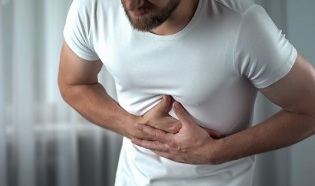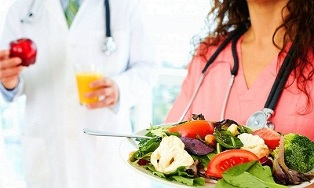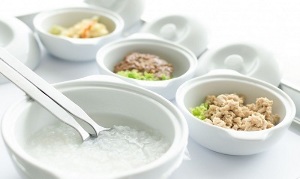Pancreatitis is a disease in which the pancreas becomes inflamed. It plays a huge role in the digestive system - it regulates energy metabolism, synthesizes digestive juices and is responsible for the breakdown of carbohydrates.
Enzymes first enter the stomach and then the duodenum, where they begin to be activated. If the pancreas is inflamed, enzymes start to “work” at an early stage, that is, even before shedding. Damage appears - the gland begins to digest itself, which causes some of the cells in the pancreas to die.

Pancreatitis can be caused by:
- infectious diseases not related to the digestive system - for example, seasonal ARVI;
- diseases of the gastrointestinal tract;
- unhealthy diet;
- stress;
- alcohol abuse.
Pancreatitis can develop in many forms - acute, reactive and chronic. In the acute phase, the pancreas may become completely or partially inflamed, the reagent develops against the background of diseases of the digestive system - gastric ulcer and duodenal ulcer, gallbladder or liver.
The chronic form can go into remission for a long time and most often the disease progresses slowly. In most cases, inflammation reappears when feeding is disturbed.
The nature of the diet in pancreatic pancreatitis plays a huge role - it is impossible to prevent an exacerbation without adhering to a special diet. What are these diets and what are the menu principles for pancreatitis?
Nutritional principles for pancreatic inflammation
The main principle, which is stated in the development of a diet, in which the work of the pancreas is normalized, is to minimize the load on the digestive organ as much as possible.
For adults during an exacerbation, doctors give the following recommendations - “hunger, cold and rest”. If the patient is in the hospital, and the pancreatitis is in the acute stage, it is advisable to refuse food for 2-3 days, and useful substances - salts and liquids - enter the body drip. If you are starving at home, it is impossible to fully guarantee the equilibrium rate of water and electrolytes. You should and can drink, but only in small portions.
Even adults need to replenish their nutrient stores. Specially designed diets come to the rescue. The most “proven” of these is Table 5.
Principles of this diet:
- create the most gentle conditions for the stomach and intestines - using mechanical and chemical unloading;
- eliminate pancreatic dysfunction;
- to avoid negative changes in liver tissue - fatty infiltration;
- reduces the excitability of the gallbladder.
The regimen should be followed not only during treatment for the disease, but also for one year after putting it into remission.
The main properties of the diet in the treatment of pancreatitis:

- In the daily menu of the day you should limit the number of products containing substances with an extractive effect - stimulating the production of pancreatic enzymes:
- refractory greases;
- purines;
- essential oils;
- cholesterol;
- coarse fiber;
- glucose.
- Diet - foods high in protein reduce the amount of carbohydrates and fats.
- Cooking technology - cooking, steaming dishes, cooking in foil, stewing.
- Fractional food - up to 6 times a day, in small portions. You have to get up from the table with a slight sensation of malnutrition so as not to overload the pancreas.
- The first time after an exacerbation, you can only eat mashed food.
- Seasonings - including salt - will have to be temporarily abandoned;
- You should not eat hot and cold food, the food should be heated to around a body temperature of 36 ° C.
Restricted alcohol regime. You can only drink as much as you want when the urge to vomit is gone completely.
Don't be afraid of dietary restrictions in the first days after an attack - fasting during treatment is only helpful.
Diet menu for pancreatitis
When composing a menu for several days with an exacerbation of pancreatitis, you should immediately take into account its characteristics - the products should be rubbed. For example, if meat - then soufflé or meatballs, potatoes - mashed potatoes, etc.
The menu consists of the following products - an approximate list of them:
- baby food - you can use both what is packaged in jars and powder, which is then diluted with liquid;
- mashed potatoes, cauliflower or white cabbage;
- mashed cottage cheese.
The proportions of nutrients in the daily menu - fat - 50-70 g, protein - 130-150 g, carbohydrate - 300-320 g.
About 2 to 4 days after the exacerbation, the nausea goes away and the amount of fluid in the body should be restored. You should drink about 1. 5 liters of water per day, in small sips, one glass every 6 hours. More "heavy" dishes are introduced into the diet gradually, after the pain is eliminated, a name for each meal.
Now - around day 4 - the menu includes the following dishes and products:
- kefir - only low in fat;
- chicken breast broth; Protein omelet
- ;
- non-acidic berry juice, diluted with half the water;
- rosehip decoction;
- up to about 30 g of honey per day;
- whole dried bread;
- unsweetened crackers or cookies;
- boiled pasta - you can not use pasta or curls, preference should be given to small vermicelli; Porridge
- is rubbed through a sieve, with pancreatitis, you can cook them from buckwheat, porridge (some nutritionists allow to eat semolina, but it should be cooked completely so that it does not swellnot in the stomach).
You can eat the following foods:
- lean meat - chicken breast, beef, rabbit;
- fish - boiled, but you can only use meat, fish soup and other soups in fish broth;
- fruit - cooked or blanched;
- meat broth - secondary;
- mashed vegetables - broccoli, cauliflower, pumpkin.
The nature of the diet in pancreatitis depends on the general condition of the patient.
How nutritional patterns change in pancreatitis
A rough diet menu in the first days after an exacerbation of chronic pancreatitis looks like this:

1 day:
- breakfast - half a portion of viscous oatmeal soup and half a glass of still mineral water;
- snack - baked apple without skin and sugar;
- lunch - mashed potatoes - also half a portion - with milk, without spices;
- afternoon snack - jelly flour and rusk;
- supper - buckwheat porridge with weak tea, bleached milk;
- bedtime - milk diluted with water.
Day 2:
- breakfast - steamed protein omelet, chamomile broth;
- snack - baked pear;
- lunch - pearl barley soup, grated on water, crouton with compote;
- afternoon tea - puffed milk;
- dinner - semolina porridge, dried fruit puree, weak tea;
- bedtime - half a glass of rosehip broth.
Additionally, the diet may be weakened slightly - if the condition has returned to normal:
- breakfast - oatmeal with dried fruits, preferably with raisins, rosehip broth;
- snack - raw banana;
- lunch - steamed fish with mashed carrots, compote of dried fruits;
- afternoon tea - cottage cheese seasoned with honey;
- dinner - porridge of rice pudding with weak tea;
- bedtime - half a glass of diluted milk.
A diet for chronic pancreatitis, when the condition has returned to normal, may look like this - a sample daily menu:
- breakfast - mashed vegetables, a piece of meat soufflé, juice diluted with water, weak tea;
- snack - protein omelet, cutlet of steamed chicken breast, a slice of dried bread, kefir;
- lunch - small noodles in chicken breast broth, boiled vegetables with a piece of steamed fish, bread, compote of dried fruits;
- afternoon tea - crackers with sweet berry jelly, maybe honey;
- dinner - steamed meatballs, rice porridge (or mashed potatoes), cooked vegetables, tea.
If you are hungry before going to bed, you can eat cracker, sweet fruit, drink a glass of kefir.
A well-designed menu in the treatment of pancreatitis will help bring the disease into remission quickly. The diet should be followed for a year after the last exacerbation.































